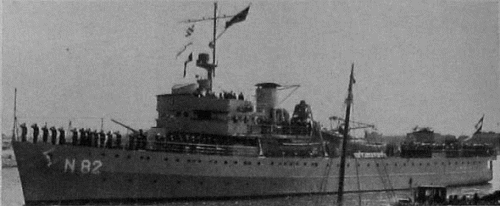

Willem van der Zaan 1945

Willem van der Zaan 1955
| Name | No | Yard No | Builder | Laid down | Launched | Comp | Fate |
| Willem van der Zaan | M08, 1946- ML2, 1950- F824, 1953- N82 | 68 | Nederlandse Dok- en Scheepsbouw Mij, Amsterdam | 1.1938 | 15.12.1938 | 8.1939 | frigate 11.1950, minelayer 1953, minesweeper tender 1.1961 |
|
Displacement standard, t |
1247 |
|
Displacement full, t |
1407 |
|
Length, m |
70.0 pp 75.2 oa |
|
Breadth, m |
11.2 |
|
Draught, m |
3.28 normal 3.90 max |
|
No of shafts |
2 |
|
Machinery |
2 VTE, 2 Yarrow boilers |
|
Power, h. p. |
2200 |
|
Max speed, kts |
15.5 |
|
Fuel, t |
oil 225 |
|
Endurance, nm(kts) |
|
|
Armament |
2 x 1 - 120/50 Wilton-Fijenoord Nr.7, 2 x 2 - 40/56 Bofors Nr.3, 2 x 2 - 12.7/90, 120 mines, 1 seaplane (C.XIW) |
|
Complement |
92 |
Project history: Last Dutch purpose-built minelayer and one of the best minelayers in the world. As well as the majority of predecessors, Willem van der Zaan was designed as double-purpose ship: minelayer and training ship, capable to accommodate 40 cadets, but differed by strengthened armament. 120mm/50 guns had rigorous fire control system. AA armament consisted from 2 twin 40mm/56 Bofors MGs with individual Hazemeyer directors, foremost for time and not having analogues in the world. On the covered mine deck ship can carry up to 120 mines. Amidships there was an area for seaplane, for which handling the crane at aft part of a superstructure was used.
Modernizations: 7.1940: - 2 x 2 - 40/56; + 1 x 4 - 40/39 QF Mk VIII, 2 DCR, sonar; mine capacity was decreased to 90 British-produced mines
1940s: + radars
1950: - 1 x 4 - 40/39, 2 x 2 - 12.7/90, 1 seaplane; + 2 x 2 - 40/60 Mk 9, 4 x 1 - 20/70 Mk 4
Naval service: 13.11.1950 Willem van der Zaan was reclassified to frigate. In the early 1961 she was converted to minesweeper support ship, since September 1963 non-self-propelled. Ship was stricken 27.2.1970 and sold on demolition 6.10.1970.

Willem van der Zaan

Willem van der Zaan 1953
Many thanks to Wolfgang Stöhr for additional information on this page.
© Ivan Gogin, 2011-15